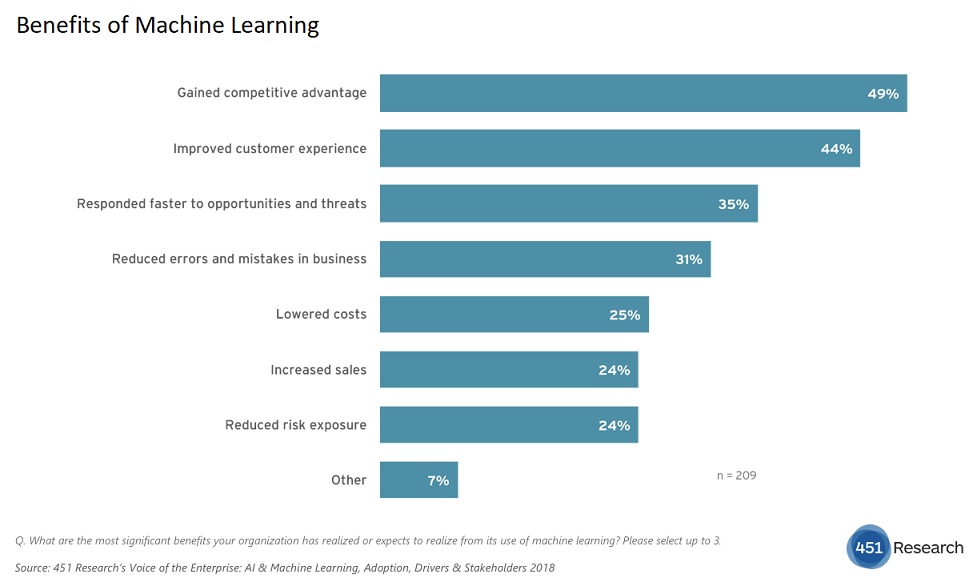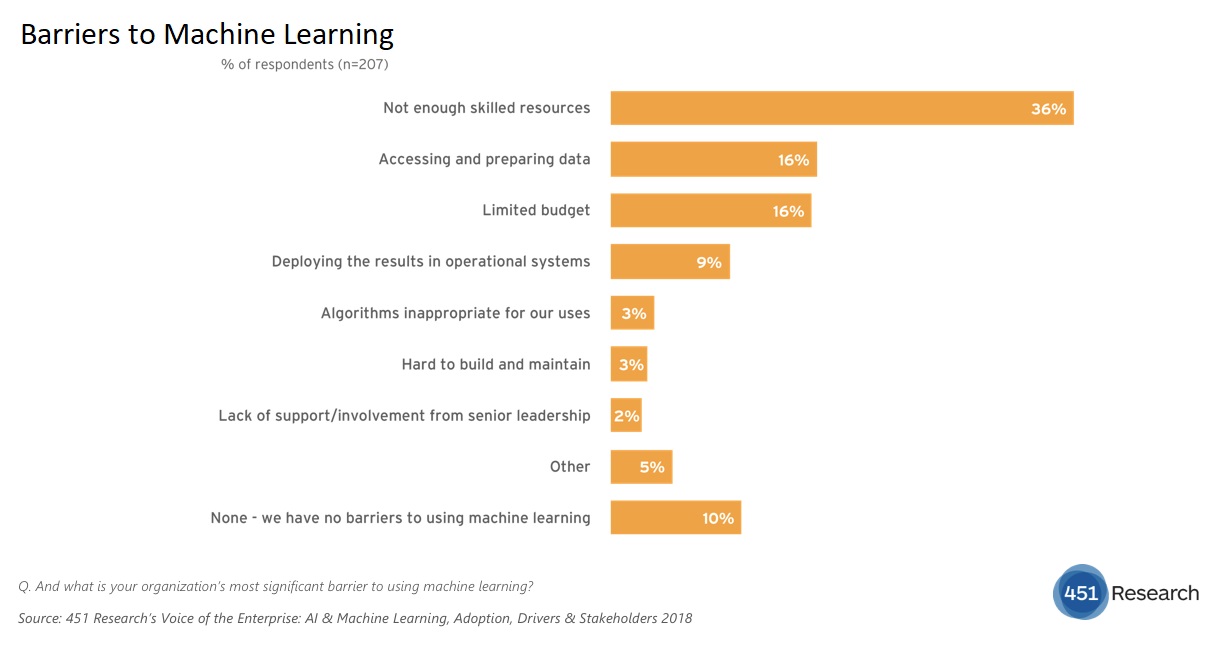Most organizations are adopting or considering adopting machine learning due to its benefits, rather than with the intention to cut people’s jobs, according to the Voice of the Enterprise (VoTE): AI & Machine Learning – Adoption, Drivers and Stakeholders 2018 survey conducted by 451 Research.
Despite being new, there is a healthy amount of adoption of these technologies already. Almost 50% of survey respondents have deployed or plan to deploy machine learning in their organizations within the next 12 months. According to Nick Patience, founder and research vice president for software at 451 Research, this paints a more realistic picture of machine learning adoption than is often portrayed.
Out of many possible benefits presented to survey respondents, almost half (49%) cited gaining competitive advantage as the most significant benefit they have received from the technology.
Improving the customer experience came a close second, cited by 44% of respondents.
Despite all the hype around mass job losses, lowering costs was cited by only a quarter of our survey respondents.
According to 451 Research, this demonstrates that AI and machine learning is an omni-purpose technology that can bring numerous benefits to organizations, beyond just lowering costs through increased automation.

Alternatively, respondents say the most significant benefit they realized or expect to realize are competitive advantages (49%) and an improved user experience for their customers (44%). This seems to indicate that decision-makers care more about the long-term impact that comes from gaining and retaining customers rather than a short-term fix that comes from cutting costs.

There are some barriers, however. When asked "what is your organization’s most significant barrier to using machine learning?" most cited a shortage of skilled resources as the top barrier (36%).
Skilled resources in the context of machine learning usually means data science skills. And a lack of those skills is reinforced further by the finding that data access and preparation is the second biggest barrier cited by survey respondents.
451 Research expects the lack of skills to gradually decline as a barrier as tools become easier to use and the population of users who can leverage machine learning expands. When all is said and done, organizations large and small will need more personnel to ensure their machine learning deployment brings the business benefits that matter most.
About Voice of the Enterprise (VoTE): AI and Machine Learning: This newest VoTE survey research report provides actionable data and insight and a broad, integrated view of enterprise AI/machine learning strategies and initiatives, their underlying business and technology driver, and the nature, pace and direction of AI/machine learning adoption. Data was collected via roughly 550 web-based surveys conducted with IT end-user decision-makers around the world from small, midsize and large enterprises in both private and public sectors.
The Latest
The use of hybrid multicloud models is forecasted to double over the next one to three years as IT decision makers are facing new pressures to modernize IT infrastructures because of drivers like AI, security, and sustainability, according to the Enterprise Cloud Index (ECI) report from Nutanix ...
Over the last 20 years Digital Employee Experience has become a necessity for companies committed to digital transformation and improving IT experiences. In fact, by 2025, more than 50% of IT organizations will use digital employee experience to prioritize and measure digital initiative success ...
While most companies are now deploying cloud-based technologies, the 2024 Secure Cloud Networking Field Report from Aviatrix found that there is a silent struggle to maximize value from those investments. Many of the challenges organizations have faced over the past several years have evolved, but continue today ...
In our latest research, Cisco's The App Attention Index 2023: Beware the Application Generation, 62% of consumers report their expectations for digital experiences are far higher than they were two years ago, and 64% state they are less forgiving of poor digital services than they were just 12 months ago ...
In MEAN TIME TO INSIGHT Episode 5, Shamus McGillicuddy, VP of Research, Network Infrastructure and Operations, at EMA discusses the network source of truth ...
A vast majority (89%) of organizations have rapidly expanded their technology in the past few years and three quarters (76%) say it's brought with it increased "chaos" that they have to manage, according to Situation Report 2024: Managing Technology Chaos from Software AG ...
In 2024 the number one challenge facing IT teams is a lack of skilled workers, and many are turning to automation as an answer, according to IT Trends: 2024 Industry Report ...
Organizations are continuing to embrace multicloud environments and cloud-native architectures to enable rapid transformation and deliver secure innovation. However, despite the speed, scale, and agility enabled by these modern cloud ecosystems, organizations are struggling to manage the explosion of data they create, according to The state of observability 2024: Overcoming complexity through AI-driven analytics and automation strategies, a report from Dynatrace ...
Organizations recognize the value of observability, but only 10% of them are actually practicing full observability of their applications and infrastructure. This is among the key findings from the recently completed Logz.io 2024 Observability Pulse Survey and Report ...
Businesses must adopt a comprehensive Internet Performance Monitoring (IPM) strategy, says Enterprise Management Associates (EMA), a leading IT analyst research firm. This strategy is crucial to bridge the significant observability gap within today's complex IT infrastructures. The recommendation is particularly timely, given that 99% of enterprises are expanding their use of the Internet as a primary connectivity conduit while facing challenges due to the inefficiency of multiple, disjointed monitoring tools, according to Modern Enterprises Must Boost Observability with Internet Performance Monitoring, a new report from EMA and Catchpoint ...





